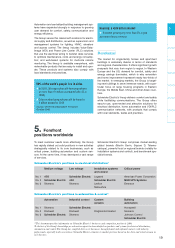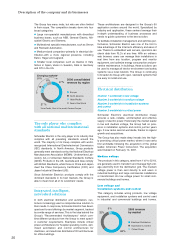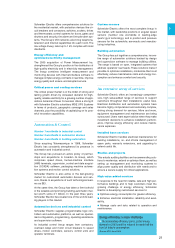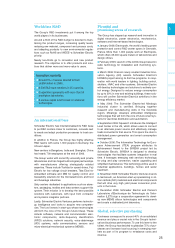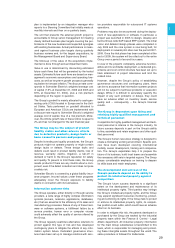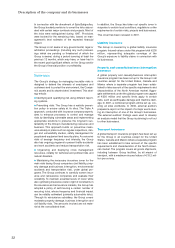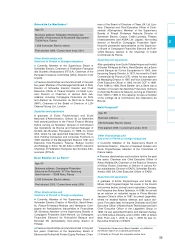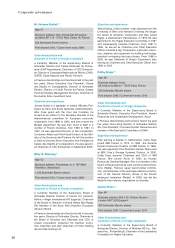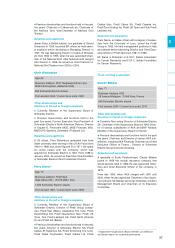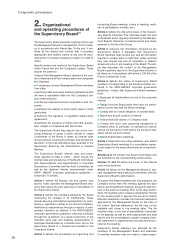APC 2006 Annual Report Download - page 30
Download and view the complete annual report
Please find page 30 of the 2006 APC annual report below. You can navigate through the pages in the report by either clicking on the pages listed below, or by using the keyword search tool below to find specific information within the annual report.
9. Risk factors
Business risks
The Group operates worldwide,
in competitive and cyclical markets
The worldwide markets for the Group’s products are
highly competitive in terms of pricing, product and
service quality, development and introduction time and
customer service. The Group faces strong competitors,
some of whom are larger or developing in certain lower
cost countries. The Group is exposed to cyclical fluctu-
ations in the rate of economic growth of, and level of
capital expenditures in, the various countries in which it
operates, though the impact of downturns in a particu-
lar market may be limited by its broad geographic reach
and the diversified nature of its end user markets.
As the Group also operates in emerging or developing
countries for around 30% of its business, it is exposed
to the risks associated with those markets.
The Group’s wide international presence exposes it to
many economic, legal and political risks in its host
countries. These include risks arising from social
unrest (particularly, strikes and walk-outs), political
instability, unforeseen regulatory changes, restrictions
on capital transfers and other obstacles to free trade,
and local tax laws, all of which may have an adverse
effect on its business, results of operations or financial
position.
The Group has implemented procedures designed to
protect it from the effects of these risks, which are gen-
erally beyond its control, and to manage them as effec-
tively as possible. The protection provided by these
measures may nevertheless prove to be inadequate.
The development and success of the
Group’s products depend on its ability to
develop new products and services and to
adapt to the market and to customer needs
The markets in which the Group operates experience
rapid and significant changes due to the introduction of
innovative technologies. Introducing new technology
products and innovative services, which the Group
must do on an ongoing basis to meet its customers’
needs, requires a significant commitment to research
and development, which may not result in success.
The Group’s sales and margins may suffer if it invests
in technologies that do not function as expected or are
not accepted in the marketplace or if its products, sys-
tems or service offers are not brought to market in a
timely manner, become obsolete or are not responsive
to customers’ requirements.
In order to meet these challenges, the Group has an
R&D budget, which, at approximately 5% of revenue,
is among the highest in the industry. R&D involves
some 6,500 employees around the world, a number of
them in development centers located in 25 countries.
This ongoing commitment has allowed the Group to
accelerate time to market and leverage the technology
of strategic partners with whom it has also forged
alliances to expand its lineup or geographic coverage.
The Group has brought together all of its electrotech-
Description of the company and its businesses
28
nical, electronic, electromechanical, software and
other technical competencies by creating technology
parks in China, the US, France and Japan.
Global support centers have also been established in
Mexico, India and China to provide the technology
parks with additional skills and development capacity
at a very competitive cost.
The Group’s business growth depends on its ability to
develop, deepen and enhance customer relationships.
The Group must constantly offer customers innovative
solutions built around high quality products and servic-
es incorporating leading edge technologies that are
closely tailored to customer needs and expectations.
However, the Group does not have any exposure with
a particular customer. Its ten largest customers repre-
sent less than 25% of its revenue.
Increasingly high customer satisfaction rates represent
an important source of competitive advantage for the
Group. It closely tracks the results of the quarterly sur-
veys conducted in 55 countries among customers rep-
resenting some 96% of annual sales. Improvement tar-
gets are set for each country, backed by specific action
plans and progress monitoring procedures.
The Group’s strategy involves growth
through acquisitions, joint ventures and
mergers, which may be difficult to identify
and/or execute
The Group’s strategy involves strengthening its capa-
bilities through acquisitions, strategic alliances, joint
ventures and mergers.
External growth projects are examined in detail by the
business units, country organizations and corporate
functions (Strategy, Finance, Legal Affairs and Human
Resources) concerned under a rigorous internal
process developed and led at Group level. A launch
committee is responsible for initiating the review
process to identify the risks and opportunities associ-
ated with each external growth project, while a valida-
tion committee reviews the results. Projects that suc-
cessfully come through the review process are submit-
ted for approval to the Group acquisitions committee
made up of the main members of senior management.
The largest projects require the prior approval of the
Management Board and, in some cases, the Supervi-
sory Board.
External growth transactions are inherently risky
because of the difficulties that may arise in integrating
people, operations, technologies and products, and
the related acquisition, administrative and other costs.
The Group has therefore developed a process for inte-
grating newly acquired businesses that extends over a
period of 6 to 24 months depending on the type and
size of the newly acquired entity. The integration sce-
nario for each acquisition varies depending on whether
the business was acquired to strengthen the Group’s
existing lineup, extend the lineup or penetrate a new
segment. All told, there are five scenarios ranging from
total integration to separate organization. Depending
on the strategic objective, a matrix is drawn up show-
ing the required level of integration for each of the
newly acquired business’s core functions, i.e. front
office (sales force and brand), back office, R&D, corpo-
rate functions and management reporting. An integra-
tion plan is drawn up for each acquisition and submit-
ted to the Acquisitions Committee for approval. The



